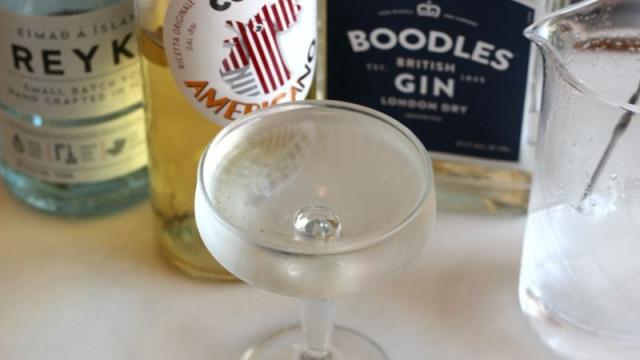Every squad has a preferred term for getting inebriated. To quote and then immediately regret quoting Eminem, “Get buzzed, get crunk, get drunk, get f**ked up.” For my particular band of uni pals, that phrase was always “Drinkin’ Outta Cups.” As in,”Hey Jack, we drinkin’ outta cups tonight?”
Almost everybody drinks and, barring beer bongs, shot-ski’s and so on, everybody drinks outta cups. Here are the fancy glass ones you need for drinking cocktails outta cups in your home.
The Coupe Glass
A cocktail’s natural home is, well, a cocktail glass (coupe, or coupet). You have doubtless seen a coupe before — they’re like martini glasses, except they’re not impossible to hold without spilling, and they have the benefit of not looking like set pieces from the Big Bad Voodoo Daddy swing dancing scene in Blast from the Past.
The logic in the coupe revolves around the ingredients, and around trusting your the person making your drink. Ingredients-wise, most cocktails — simple or complex — fall into the categories of martinis/Manhattans, sours, and old fashioneds.
Of these, Manhattan-style cocktails and sours both have enough extra stuff going on (vermouth, additional modifiers like bitters and liqueurs, sugar, and/or citrus) that they’re naturally not too boozy. They can therefore be served up, and don’t need or benefit from additional dilution by way of ice.
Cocktails, properly mixed by someone who knows what they’re doing, come to you balanced, perfectly diluted, and cold as hell. The mixer has carefully added the correct amount of water by shaking or stirring, so you don’t want to mess that up with extra ice, or warm it up by getting your grubby hands all over it, which is where the stem comes in.
Generally speaking, you also want a coupe that is a bit larger than the total volume of your drink. This prevents spillage, and also aids in harnessing aromatics, be they naturally occurring in your chosen spirits, or added via a citrus twist, an absinthe rinse, or a couple drops of orange blossom water (a very tasty trick for all manner of sours).
Side note: Some people (men) always seem averse to (scared of) any stemware that isn’t made for holding a big, bold California red or a few manly fingers of whisky. Frequently, bartenders will try to lull these lugs with a story about how the coupe glass was originally moulded after the shape of Marie Antoinette’s breast, but frankly, if you need a story about holding a boob to soothe your fragile masculinity, you should just grow up.
The Double Rocks Glass
While most cocktails shouldn’t require extra dilution after mixing, some cocktails, particularly old fashioned-style beverages, benefit from it greatly. By “old fashioned-style,” we mean cocktails that follow a template of spirit, sweetener, modifier, and water.
Most commonly this means whisky, sugar (or sugar syrup), bitters, and ice, but it can just as easily mean any barrel-aged spirit — rum, tequila, barrel-aged gin, genever, WHATEVER — and a sweet liqueur or amaro or combination thereof, which can do the work of the sweetener AND the modifier all at once. Among the great pleasures of these simpler drinks is the gradual evolution of their flavour as they dilute.
Similarly, some sours — punches, tiki drinks and such — need a little extra water because their ingredients may otherwise be overly sweet, viscous, boozy, or otherwise unpleasant. In all of these cases, you’ll want to tailor the type of ice you use to your desired level of additional dilution.
The point is these drinks need ice, and a double rocks glass can hold all that ice. A big fat cube works great in an old fashioned as it’s a slow, spirituous sipper, regular 2.5cm cubes work better in a punch or patio-pounder, and crushed or pellet ice works well for boozy as heck tiki drinks by providing maximum chill. In any of these cases, though, a regular double rocks glass does the job.
The Collins Glass
Collins glasses serve the same function as champagne flutes — they’re longer and taller to get maximum effervescence out of whatever fizzy ingredients you’re adding. They tend to be a little bigger volume-wise, to accommodate the 45-75mL of additional liquid you’re adding to your base sour or spritz, and also happen to make you (me) feel like you’re (I’m) on holiday.
Similar to double rocks glasses, you’ll want to tailor your ice to your situation, bearing in mind that soda water is still water, so these drinks will inherently be a little looser from the get-go.
Anything else, glass-wise, is probably non-essential, though glassware trends, like any others, still oscillate wildly. Stemmed wine-glasses are currently en-vogue for all manner of sours, collins, and spritzes, as are chunks of ice floating in oversized coupes. Manhattans can be served up in a rocks glass, and Sazeracs perennially defy all manner of convention.
All of these things are subject to taste. If, however, your end game is to get hammered, hammed, ham-hocked, sloshed, or soused, you probably just need to drink outta cups, and these three cups will do just fine.

Comments